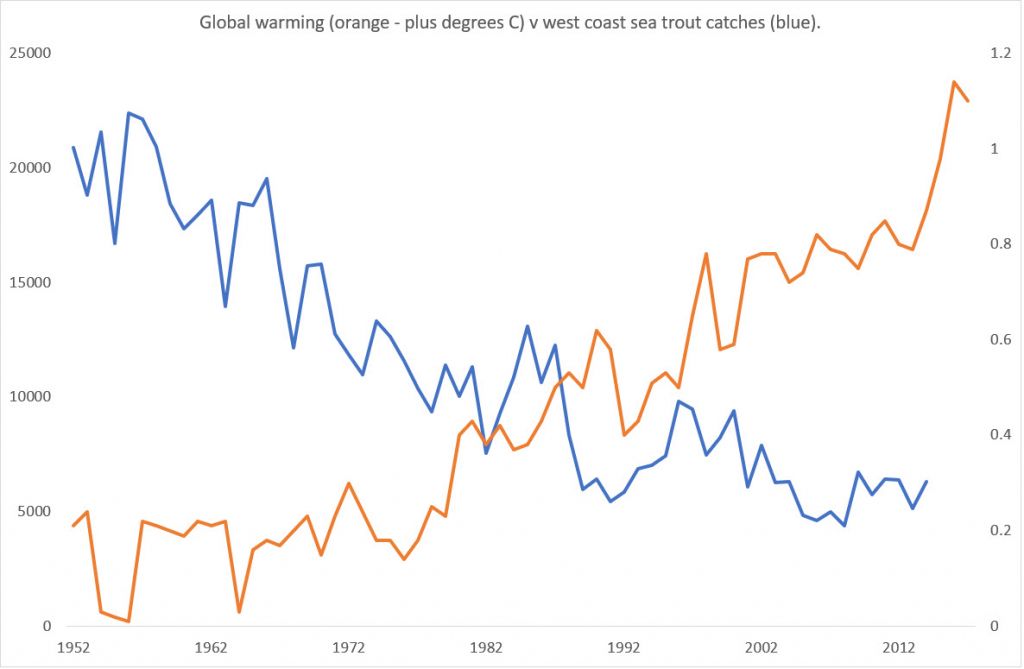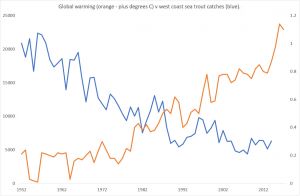Milestone: Last week, the BC Salmon Farmers Association sent a letter to the Prime Minister and the Premier on behalf of 70 of their association’s diverse membership and copied to a wide range of groups and organisations.
The key part of this letter was the last paragraph which starts:
‘The science tells us that done responsibly, salmon farming does not negatively impact wild fish populations.’
This is undoubtedly a landmark statement from an important section of the salmon farming family. I now look forward to other salmon industry national organisations joining their colleagues in BC in issuing similar statements.
For far too long, the salmon farming industry has listened to a well-worn narrative that salmon farming is a key driver in wild salmon declines despite a lack of any real evidence. As my recent video showed, the removal of salmon farms from the Broughton Archipelago has made no difference to the lice counts. Lice levels were always probably this high but because no-one bothered to look before the advent of salmon farming, the assumption has always been that higher lice levels area associated with salmon farming. Having argued over so many years that salmon farming is to blame, the industry critics find it extremely difficult to accept that their narrative has passed its sell-by date.
The problem is that it has been difficult to challenge these long-standing beliefs. When someone does, as I have done and continue to do so, they are ridiculed, abused or ostracised. The simple fact is that many in the wild fish sector simply blame salmon farming in an attempt to deflect attention away from other issues. The time has come that if the wild fish sector is so convinced of their claims, they need to be prepared to defend them in open discussion. Unsubstantiated claims about salmon farming are just no longer acceptable or justified. Yet, such claims continue even today.
The BBC news website reported last week that a group of salmon pens had broken free from their moorings during Storm Ellen. Andrew Graham Stewart of Salmon & Trout Conservation told the BBC that the consequences of such a large number of mature farmed salmon of Norwegian origin escaping into the environment were potentially ‘very serious’.
He continues to say that ‘They are likely to run into the rivers of Argyll, the Firth of Clyde and Ayrshire in great number and, by spawning and breeding with wild Scottish salmon, severely impact the genetic integrity of our depleted native salmon populations.’
In a previous reLAKSation, I invited Mr Graham Stewart to write a guest blog in response to my recent comments and videos about the decline of wild fish catches. I hope that when Mr Graham Stewart gets round to writing his commentary. he will use the opportunity to expand on his comments to the BBC because frankly what he told the BBC is simply a scare story based on conjecture rather than evidence.
The fundamental problem is that Mr Graham Stewart appears to equate large salmon with mature salmon. He has also made the same assumption with sea trout. Just because the fish are large does not mean that they are mature i.e. that they will breed. There is no evidence that the fish from the affected site were sexually mature or ready to breed.
There’s also no evidence that these fish would head up rivers in ‘great number’. The Government catch statistics show that those fish caught in Scottish rivers and deemed to be farm escapes accounted for 0.04% of the catch and given that anglers may be prevented from killing wild fish but allowed to kill escapes, the attribution of some of these fish might have been mistaken.
Over the years, farmed salmon have often been described as weak, deformed flabby fish and nothing like truly wild salmon. It is therefore difficult to understand how such fish can successfully breed with wild fish and so pass on their inferior genetics.
Mt Graham Stewart claims escaped salmon will severely impact the genetic integrity of already depleted native salmon populations. However, the genetic integrity of Scottish salmon was compromised long ago. Rivers were often stocked with fish from other rivers. At the same time, some owners were happy to knock on the doors of farm salmon hatcheries asking for fish to restock, but the greatest impact on the genetics has been through genetic drift and the loss of much the gene pool due to excessive over-exploitation especially during the late nineteenth and early twentieth centuries.
The Rivers & Fisheries Trusts of Scotland invested over £1 million in the FASMOP study. This seems to have been wiped from history as it is rarely mentioned. Principally, the study failed to find the genetic differences that had been anticipated. At the time, this was blamed on the methodology but why this was never tested before such a large investment took place is unclear.
Mr Graham Stewart’s colleague at Inside Scottish Salmon Feedlots has posted a video with the following statements:
“When escaped farm salmon breed with wild fish weak deformed offspring are produced and wild salmon populations are wiped out.”
Whilst this narrative suits those who blame salmon farming for declining wild stocks, there is very little evidence to support their claims. The fact is that genetic evolution is controlled by Darwinian theory of survival of the fittest or those that are best adapted to their local environment. If interbred salmon are weak and deformed, they simply will not survive or in the unlikely event they did and they managed to breed, the unfit genes would be bred out. Perhaps, wild salmon populations are being wiped out for other reasons?
Speaking to the Adrossan Herald, Dr Alan Wells of Fisheries Management Scotland said that in Norway, interbreeding between wild and escaped farmed fish is considered the greatest threat to wild salmon. This isn’t surprising since creating a negative image about salmon farming in Norway also generates substantial research funding opportunities for scientists and institutions.
Of course, those controlling the narrative ensure that only the research that supports their claims is given exposure. Research supporting an alternative view is rarely heard. One peer reviewed scientific paper that has rarely seen the light of day is by Green et. al. of Stirling University. This looks at the impact of escapes on river catches. The paper from 2012 and published in PLoS One examined specific escape incidents and then measured detections of escaped fish in local rivers over a five-year period. The study found that following any incident, there was no increase in the number of escaped fish caught and equally catches of wild fish did not change.
Dr Wells helpfully told the Adrossan Herald that farmed fish are identifiable because of deformed or shortened features such as their fins, gill covers and snouts, He added that pigmentation can also be heavier with more spots than are usual on wild salmon.
Given all these deformities and their genetic weakness, it is surprising that any farmed salmon reach the market at all, let alone the breeding grounds of Scottish rivers.
Price to Pay: The Sunday Times reported last weekend that according to leaked documents “Scotland’s fish farming industry has been secretly lobbied to fund government-backed research into the decline of wild salmon and allegations of a ‘serious’ conflict of interest.”
No-one seems to have told the Sunday Times that the revelations that appear in the article were published last year. This is old news that in my opinion has been rehashed at the suggestion of Salmon & Trout Conservation who since their departure from the Missing Salmon Alliance are trying to demonstrate their position as the only people able to safeguard the future of wild salmon. Unfortunately, as I have written before now, they increasingly appear to be not only out of touch but also left behind.
It’s not necessary to discuss again whether the salmon industry believe that funding a joint research project would really convince the wild fish sector to weaken their demand for increased regulation. The aim of Salmon Interactions Working Group is increased cooperation and hence funding from Government boosted by contributions from both the wild and farmed sectors.
The same message appeared in the latest issue of Trout & Salmon magazine and because Andrew Graham Stewart is a contributor, the explanation is more revealing. The report states that Salmon and Trout Conservation believe that SIWG had moved beyond its remit of wild and farmed salmon interactions and included consideration of wider conservation of wild salmonids. “Salmon & Trout Conservation believe that this was an attempt to let ‘aquaculture off the hook’ and blame other causes for wild salmon declines.”
This statement raises a number of different issues, but I first want to focus on the letting aquaculture off the hook and blaming other causes.
In 2011, the Rivers & Fisheries Trusts of Scotland produced a report that refuted claims made by the SSPO about wild fish declines. The important point was that RAFTS published a graph showing the different trajectories of catches from east and west rivers. The graph shows the percent change in catches from 1970, which is taken as 100%.
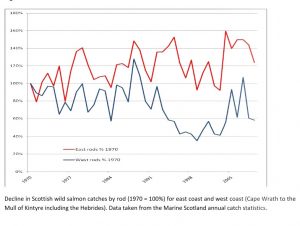
RAFTS states that this graph shows the true difference between the east and west coast fisheries. East coast catches have increased by 24% from 1970 to 2009, whilst those on the west have declined by 42%. The discussion relates to the impact of aquaculture only on catches. The full document can be viewed at https://www.yumpu.com/en/document/read/52138411/comparison-of-the-decline-of-scottish-east-and-west-coast-rafts
I have previously argued that this comparison is flawed since catches were already changing before 1970; the rivers of the east coast are very different to those of the west coast and that the east coast catches are nine times greater than those of the west coast. However, in the interests of this commentary I will ignore these questions. Instead, I would mention that S&TC reported the analyses at the time https://www.salmon-trout.org/2011/06/24/marked-decline-in-scottish-wild-atlantic-salmon-stocks-confirmed-in-salmon-farming-areas/ as well as providing links to the various documents. Since changing their name and their website, these links no longer work. The new website also has no link to an updated version of the graph that S&TC subsequently used in their crusade against the salmon farming industry. Since then, this approach has been largely forgotten.
I have now extended this graph using exactly the same calculation:
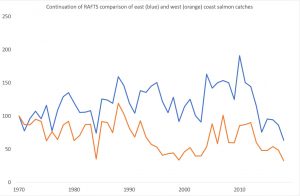
So now rather than increasing by 24% over 1970 catches, east coast rivers have fallen to – 36.6% whilst west coast river catches have fallen to -67.5% of the 1970s catch. Catches from both coasts have fallen well below the 1970 catch.
The following graph is the data from the last decade. What is clear is that the catches from both coasts are in decline with east coast catches in decline at a faster rate.

What has already been established by RAFTS is that there is a clear trend of declining catches in areas where aquaculture operates, compared to the east coast where there are no salmon farms. Therefore, it is absolutely clear that declining catches along the east coast cannot be due to salmon farming. These catches are in decline due to some other cause. West coast catches are also in decline and according to what RAFTS have said, this decline must be due to aquaculture, even though the declines along both coasts are now at a similar rate with the possibility that the cause could be the same on both coasts.
Yet, Salmon & Trout Conservation say that there cannot be another cause. West coast declines must be due to salmon farming and because east coast catches are not impacted by salmon farms, the decline there must be for another reason. As SIWG is about wild farm salmon interactions, I, or anyone else cannot even consider why the east coast catches have declined because any such discussion will deflect attention away from the real issue, which is the impact of salmon farming.
Salmon & Trout Conservation, an organisation supposedly dedicated to the conservation of wild salmon are only interested in the impact of salmon farming. To them any consideration of the 12 pressures affecting wild salmon as highlighted by the Scottish Government is akin to selling out on wild salmon. As far as they are concerned salmon farming is the only topic on the table.
Despite their reluctance to look at other issues, I am more than willing to do so. I would like to refer to a graph that I have repeatedly included in past commentaries. This is the graph of sea trout catches from rivers in the Aquaculture Zone. To-date, despite repeated requests, not one person from the wild fish sector has offered an explanation as to why sea trout catches were already in decline before the advent of salmon farming in the area and why the decline since the 1980s could be for the same reason as that which caused the decline before the 1980s. My interpretation is that something else other than salmon farming has caused the decline.
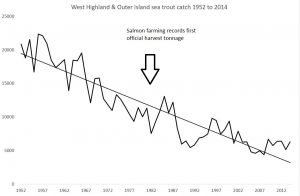
I would hope that Mr Graham Stewart is willing to provide an explanation of this graph but of course, I would be equally happy to hear from anyone in the sector including from the experts at the Atlantic Salmon Trust, Fisheries Management Scotland, Inside Scottish Salmon Feedlots, Marine Scotland Science or even from the experts in Norway. I hope that they will all feel free to shed light on why west coast sea trout catches have declined since the 1950s.
Whilst I wait for any response, and I except a long wait, I would like to offer a possible suggestion. I have obtained data from NASA regarding global warming and climate change. I have added their data to this graph. You can draw your own conclusions.
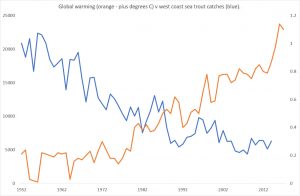
River Classification: The Scottish Government have just issued the proposed classification for rivers in Scotland with regard to salmon conservation.
Despite claims that salmon farming has destroyed wild salmon populations along the west coast, the proposed gradings for 2021 include 10 Grade 1 rivers and 19 Grade 2 rivers. The numbers in black are the Government figures for all Grade 1 and Grade 2 rivers in Scotland. The numbers in red are the totals for rivers within the Aquaculture Zone.
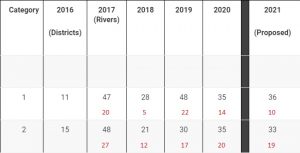
It seems that it is still possible to catch and kill wild salmon in the Aquaculture Zone for sport, despite the close proximity of salmon farms. Who would have thought it!!!

